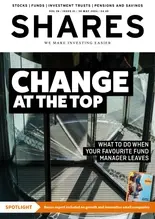
- Online retailer reports 90% profits plunge
- Shares rally as new CEO sets out recovery plan
- ASOS has renegotiated banking facilities
It has been a disastrous year for ASOS (ASC) shareholders, who have seen the stock plunge almost 80% on a series of downgrades.
However, the online fast fashion retailer rallied 9.3% to 535.5p on news of a ‘slight’ improvement in trading in September and as new CEO Jose Antonio Ramos Calamonte outlined his turnaround plan, having performed a ‘diagnostic’ of the issues ASOS faces.
WHY ARE SHARES IN ASOS RALLYING?
Dire figures for the year to 31 August 2022 were already priced in and the in-line results duly revealed a near-90% plunge in adjusted pre-tax profit to just £22 million on revenue up a meagre 1% to £3.94 billion.
During a difficult year, ASOS’s skinny margins were squeezed by rising costs including higher product returns and growth proved tougher to eke out amid an escalating cost-of-living crisis.
Growth was lower than expected in the second half as inflationary pressures on the consumer increased as the year progressed, denting consumers’ confidence and eroding discretionary income.
On a more positive note, the Topshop brand saw increased revenue growth across all key territories with an overall sales growth rate of 105%,which exceeded 200% in the US.
WHAT IS CALAMONTE’S TURNAROUND PLAN?
ASOS also assuaged recent fears over a cash flow squeeze and credit insurance concerns with news it has renegotiated banking covenants, with cash and committed facilities of over £650 million at year end providing the headroom and flexibility to cope with tough times ahead.
Calamonte also set out ‘a clear change agenda’ to strengthen ASOS and ‘reorient our business towards the future’.
Measures outlined to improve the business include a renewed commercial model, stronger order economics and a lighter cost profile, a robust balance sheet and a reinformed leadership team and refreshed culture.
Calamonte is also taking action to revive the fortunes of the underperforming international arm.
Outside the UK, he sees a ‘significant need to improve the way we operate to unlock the opportunity of our global reach. In recent years, the quest for growth has resulted in ASOS becoming excessively capital intensive, too complex and overstretched globally, which has resulted in a lack of meaningful growth and scale in its key international markets of the US, France and Germany.’
He added: ‘While the international business makes a positive contribution and there are pockets of strength in key territories, we are disappointed in our performance, given the extent of our historical capital investment, particularly in the US.’
For full year 2023, the guidance from ASOS is essentially no guidance given macroeconomic volatility and unpredictable consumer demand. However in the UK, the retailer expects to take share in a clothing market set to decline over the next 12 months.
ASOS will also ‘right-size’ its bloated inventory in the first half, resulting in a non-cash write-down of between £100 million and £130 million, while discounts to shift stock will be a factor behind the first half loss management is forecasting.
WHAT ARE THE EXPERTS SAYING?
AJ Bell investment director Russ Mould warned the outlook for ASOS’s sales is weak as its youthful target audience, ‘or their parents, face significant pressures on their disposable income.
‘Crucially, recently appointed CEO Jose Antonio Ramos Calamonte has demonstrated he is taking the challenges in front of the company seriously.
‘Some of the things he is looking at, like stock management, are basics of the retail industry and really things ASOS should have already had under control. When times were good it could perhaps afford to neglect these issues. Not anymore. Costs are being cut and ASOS may have to follow the lead of other retailers and start charging for returns.’
Mould added: ‘ASOS’s current predicament is only adding to longer-term concerns about the whole fast fashion model and whether, in an age when the focus is on sustainability and where sourcing cheap materials and labour is a much bigger challenge, it has as solid a future as previously thought.’
Russell Pointon, consumer director at Edison, commented: ‘With the macroeconomic environment remaining significantly volatile, ASOS is rightly concerned about consumer demand, expecting a decline in apparel over the next year.
‘The group will need to focus on the strong brands in its portfolio, its loyalty-based Premier programme and continue to invest in the customer experience through technological investment if it is to weather the continued storm. It will also need to reinforce its efforts in marketing, with a lack of prioritisation slowing customer acquisition this year.’
DISCLAIMER: Financial services company AJ Bell referenced in this article owns Shares magazine. The author of this article (James Crux) owns shares in AJ Bell.






